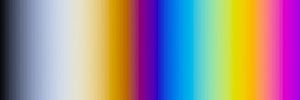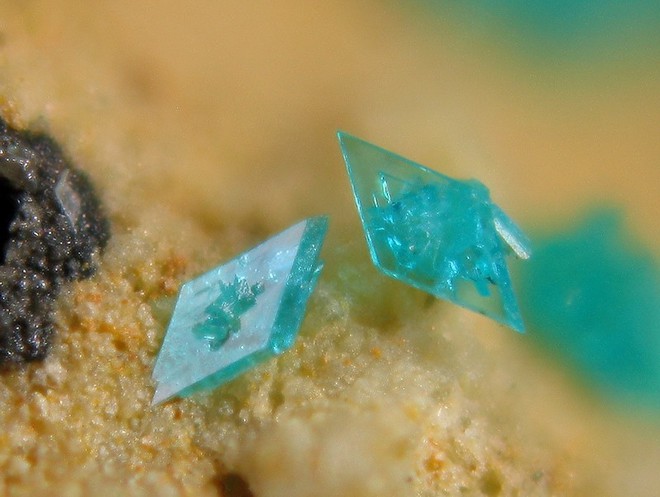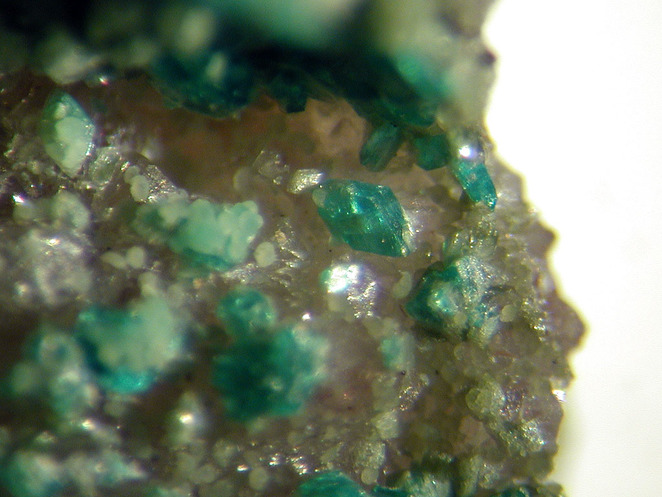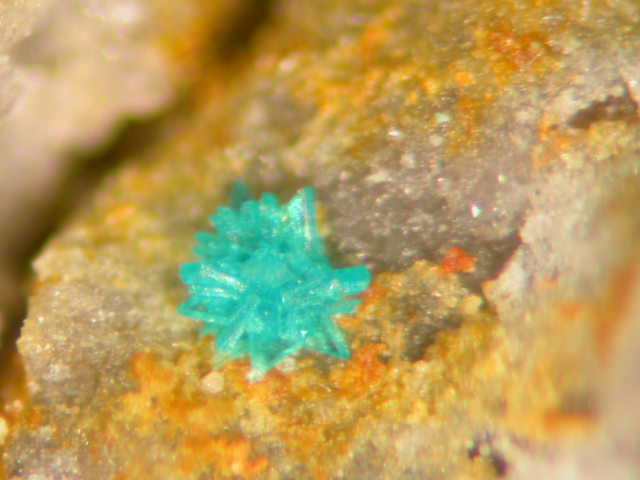Nissonite
A valid IMA mineral species
This page is currently not sponsored. Click here to sponsor this page.
About Nissonite
Formula:
Cu2Mg2(PO4)2(OH)2 · 5H2O
Colour:
Bluish green to deep blue, turquoise-blue
Hardness:
2½
Specific Gravity:
2.73
Crystal System:
Monoclinic
Name:
Named for William H. Nisson (1912–1965), amateur mineralogist, mineral collector and dealer, of Petaluma, California, USA, who first noted the mineral.
This page provides mineralogical data about Nissonite.
Unique Identifiers
Mindat ID:
2915
Long-form identifier:
mindat:1:1:2915:1
GUID
(UUID V4):
(UUID V4):
de078f3e-5eb0-4f91-9b1e-a36740eabe79
IMA Classification of Nissonite
Approved
Approval year:
1966
First published:
1966
Classification of Nissonite
8.DC.05
8 : PHOSPHATES, ARSENATES, VANADATES
D : Phosphates, etc. with additional anions, with H2O
C : With only medium-sized cations, (OH, etc.):RO4 = 1:1 and < 2:1
8 : PHOSPHATES, ARSENATES, VANADATES
D : Phosphates, etc. with additional anions, with H2O
C : With only medium-sized cations, (OH, etc.):RO4 = 1:1 and < 2:1
42.7.5.1
42 : HYDRATED PHOSPHATES, ETC.CONTAINING HYDROXYL OR HALOGEN
7 : (AB)2(XO4)Zq·xH2O
42 : HYDRATED PHOSPHATES, ETC.CONTAINING HYDROXYL OR HALOGEN
7 : (AB)2(XO4)Zq·xH2O
19.2.6
19 : Phosphates
2 : Phosphates of Cu
19 : Phosphates
2 : Phosphates of Cu
Mineral Symbols
As of 2021 there are now IMA–CNMNC approved mineral symbols (abbreviations) for each mineral species, useful for tables and diagrams.
| Symbol | Source | Reference |
|---|---|---|
| Nss | IMA–CNMNC | Warr, L.N. (2021). IMA–CNMNC approved mineral symbols. Mineralogical Magazine, 85(3), 291-320. doi:10.1180/mgm.2021.43 |
Pronunciation of Nissonite
Pronunciation:
| Play | Recorded by | Country |
|---|---|---|
| Jolyon Ralph | United Kingdom |
Physical Properties of Nissonite
Transparency:
Translucent
Colour:
Bluish green to deep blue, turquoise-blue
Hardness:
2½ on Mohs scale
Cleavage:
Imperfect/Fair
{100}, fair.
{100}, fair.
Density:
2.73(1) g/cm3 (Measured) 2.782 g/cm3 (Calculated)
Optical Data of Nissonite
Type:
Biaxial (-)
RI values:
nα = 1.584(2) nβ = 1.620(2) nγ = 1.621(2)
2V:
Measured: 19° , Calculated: 18°
Max Birefringence:
δ = 0.037

Image shows birefringence interference colour range (at 30µm thickness)
and does not take into account mineral colouration.
and does not take into account mineral colouration.
Surface Relief:
Moderate
Dispersion:
small
Optical Extinction:
Z = b; X ∧ a = 15°; Y ∧ c = 6°.
Pleochroism:
Weak
Comments:
X = colorless; Y = Z = turquoise-blue.
Chemistry of Nissonite
Mindat Formula:
Cu2Mg2(PO4)2(OH)2 · 5H2O
Crystallography of Nissonite
Crystal System:
Monoclinic
Class (H-M):
2/m - Prismatic
Space Group:
B2/b
Setting:
C2/c
Cell Parameters:
a = 22.523(5) Å, b = 5.015(2) Å, c = 10.506(3) Å
β = 99.62(2)°
β = 99.62(2)°
Ratio:
a:b:c = 4.491 : 1 : 2.095
Unit Cell V:
1,170.00 ų (Calculated from Unit Cell)
Z:
4
Morphology:
Aggregates and crusts. Rare crystals are tabular on {100}, elongated along [001], and diamond-shaped. Forms include {001}, {100}, {111}.
Crystal Structure
Load
Unit Cell | Unit Cell Packed
2x2x2 | 3x3x3 | 4x4x4
Unit Cell | Unit Cell Packed
2x2x2 | 3x3x3 | 4x4x4
Show
Big Balls | Small Balls | Just Balls | Spacefill
Polyhedra Off | Si Polyhedra | All Polyhedra
Remove metal-metal sticks
Big Balls | Small Balls | Just Balls | Spacefill
Polyhedra Off | Si Polyhedra | All Polyhedra
Remove metal-metal sticks
Display Options
Black Background | White Background
Perspective On | Perspective Off
2D | Stereo | Red-Blue | Red-Cyan
Black Background | White Background
Perspective On | Perspective Off
2D | Stereo | Red-Blue | Red-Cyan
View
CIF File Best | x | y | z | a | b | c
CIF File Best | x | y | z | a | b | c
Rotation
Stop | Start
Stop | Start
Labels
Console Off | On | Grey | Yellow
Console Off | On | Grey | Yellow
Data courtesy of the American Mineralogist Crystal Structure Database. Click on an AMCSD ID to view structure
| ID | Species | Reference | Link | Year | Locality | Pressure (GPa) | Temp (K) |
|---|---|---|---|---|---|---|---|
| 0001329 | Nissonite | Groat L A, Hawthorne F C (1990) The crystal structure of nissonite American Mineralogist 75 1170-1175 |  | 1990 | 0 | 293 |
CIF Raw Data - click here to close
X-Ray Powder Diffraction
Powder Diffraction Data:
| d-spacing | Intensity |
|---|---|
| 10.8 Å | (100) |
| 4.36 Å | (70) |
| 3.72 Å | (55) |
| 2.768 Å | (100) |
| 2.679 Å | (60) |
| 2.531 Å | (55) |
| 2.218 Å | (65) |
Geological Environment
Paragenetic Mode(s):
| Paragenetic Mode | Earliest Age (Ga) |
|---|---|
| Stage 7: Great Oxidation Event | <2.4 |
| 47a : [Near-surface hydration of prior minerals] | |
| 47c : [Carbonates, phosphates, borates, nitrates] |
Type Occurrence of Nissonite
General Appearance of Type Material:
Diamond shaped crystals and thin crusts.
Place of Conservation of Type Material:
No defined type material.
Geological Setting of Type Material:
In metamorphic rocks of the Franciscan Formation.
Associated Minerals at Type Locality:
Reference:
Mrose, M.E., R. Meyrowitz, J.T. Alfors & C.W. Chesterman (1966), Nissonite, CMg(PO4)(OH)•2½H2O, a new hydrous copper-magnesium-phosphate mineral from Panoche Valley, California: Geological Society of America Abstracts, 1966: 145-146.
Synonyms of Nissonite
Other Language Names for Nissonite
Relationship of Nissonite to other Species
Structurally related to group(s):
| Spiroffite Group | M2Te4+3O8 |
Common Associates
Associated Minerals Based on Photo Data:
| 2 photos of Nissonite associated with Chrysocolla | Cu2-xAlx(H2-xSi2O5)(OH)4 · nH2O, x < 1 |
| 1 photo of Nissonite associated with Glaucophane | ◻[Na2][Mg3Al2]Si8O22(OH)2 |
| 1 photo of Nissonite associated with Phosphohedyphane | Ca2Pb3(PO4)3Cl |
Related Minerals - Strunz-mindat Grouping
| 8.DC. | Ianbruceite | Zn2(AsO4)(OH) · 3H2O |
| 8.DC. | Césarferreiraite | Fe2+ Fe3+2(AsO4)2(OH)2 · 8H2O |
| 8.DC. | Ferrivauxite | Fe3+Al2(PO4)2(OH)3 · 5H2O |
| 8.DC.07 | Euchroite | Cu2(AsO4)(OH) · 3H2O |
| 8.DC.10 | Legrandite | Zn2(AsO4)(OH) · H2O |
| 8.DC.12 | Strashimirite | Cu8(AsO4)4(OH)4 · 5H2O |
| 8.DC.15 | Arthurite | CuFe3+2(AsO4)2(OH)2 · 4H2O |
| 8.DC.15 | Earlshannonite | Mn2+Fe3+2(PO4)2(OH)2 · 4H2O |
| 8.DC.15 | Ojuelaite | ZnFe3+2(AsO4)2(OH)2 · 4H2O |
| 8.DC.15 | Whitmoreite | Fe2+Fe3+2(PO4)2(OH)2 · 4H2O |
| 8.DC.15 | Cobaltarthurite | (Co,Mg)Fe3+2(AsO4)2(OH)2 · 4H2O |
| 8.DC.15 | Bendadaite | Fe2+Fe3+2(AsO4)2(OH)2 · 4H2O |
| 8.DC.15 | Kunatite | CuFe3+2(PO4)2(OH)2 · 4H2O |
| 8.DC.15 | UM2006-27-PO:FeHZn | ZnFe3+2(PO4)2(OH)2 · 4H2O |
| 8.DC.15 | UKI-2006-(PO:AlCuFeH) | Fe2+Al3+2(PO4)2(OH)2 · 4H2O |
| 8.DC.17 | Kleemanite | ZnAl2(PO4)2(OH)2 · 3H2O |
| 8.DC.20 | Bermanite | Mn2+Mn3+2(PO4)2(OH)2 · 4H2O |
| 8.DC.20 | Coralloite | Mn2+Mn3+2(AsO4)2(OH)2 · 4H2O |
| 8.DC.20 | Magnesiobermanite | MgMn3+2(PO4)2(OH)2 · 4H2O |
| 8.DC.22 | Kovdorskite | Mg2(PO4)(OH) · 3H2O |
| 8.DC.25 | Ferristrunzite | Fe3+Fe3+2(PO4)2(OH)3 · 5H2O |
| 8.DC.25 | Ferrostrunzite | Fe2+Fe3+2(PO4)2(OH)2 · 6H2O |
| 8.DC.25 | Metavauxite | Fe2+Al2(PO4)2(OH)2 · 8H2O |
| 8.DC.25 | Metavivianite | Fe2+Fe3+2(PO4)2(OH)2 · 6H2O |
| 8.DC.25 | Strunzite | Mn2+Fe3+2(PO4)2(OH)2 · 6H2O |
| 8.DC.25 | Zincostrunzite | ZnFe3+2(PO4)2(OH)2 · 6.5H2O |
| 8.DC.27 | Beraunite | Fe3+6(PO4)4O(OH)4 · 6H2O |
| 8.DC.27 | Tvrdýite | Fe2+Fe3+2 Al3(PO4)4(OH)5(H2O)4 · 2H2O |
| 8.DC.27 | Zincoberaunite | ZnFe3+5(PO4)4(OH)5 · 6H2O |
| 8.DC.30 | Gordonite | MgAl2(PO4)2(OH)2 · 8H2O |
| 8.DC.30 | Laueite | Mn2+Fe3+2(PO4)2(OH)2 · 8H2O |
| 8.DC.30 | Mangangordonite | Mn2+Al2(PO4)2(OH)2 · 8H2O |
| 8.DC.30 | Paravauxite | Fe2+Al2(PO4)2(OH)2 · 8H2O |
| 8.DC.30 | Pseudolaueite | Mn2+Fe3+2(PO4)2(OH)2 · 8H2O |
| 8.DC.30 | Sigloite | Fe3+Al2(PO4)2(OH)3 · 7H2O |
| 8.DC.30 | Stewartite | Mn2+Fe3+2(PO4)2(OH)2 · 8H2O |
| 8.DC.30 | Ushkovite | MgFe3+2(PO4)2(OH)2 · 8H2O |
| 8.DC.30 | Ferrolaueite | Fe2+Fe3+2(PO4)2(OH)2 · 8H2O |
| 8.DC.30 | Kastningite | (Mn2+,Fe2+,Mg)Al2(PO4)2(OH)2 · 8H2O |
| 8.DC.30 | Maghrebite | MgAl2(AsO4)2(OH)2 · 8H2O |
| 8.DC.30 | Nordgauite | MnAl2(PO4)2(F,OH)2 · 5H2O |
| 8.DC.30 | Kayrobertsonite | [MnAl2(PO4)2(OH)2(H2O)4] · 2H2O |
| 8.DC.30 | Kummerite | Mn2+Fe3+Al(PO4)2(OH)2 · 8H2O |
| 8.DC.32 | Tinticite | Fe3+3(PO4)2(OH)3 · 3H2O |
| 8.DC.32 | Kamarizaite | Fe3+3(AsO4)2(OH)3 · 3H2O |
| 8.DC.35 | Vauxite | Fe2+Al2(PO4)2(OH)2 · 6H2O |
| 8.DC.37 | Vantasselite | Al4(PO4)3(OH)3 · 9H2O |
| 8.DC.40 | Cacoxenite | Fe3+24AlO6(PO4)17(OH)12 · 75H2O |
| 8.DC.45 | Gormanite | (Fe2+,Mg)3(Al,Fe3+)4(PO4)4(OH)6 · 2H2O |
| 8.DC.45 | Souzalite | (Mg,Fe2+)3(Al,Fe3+)4(PO4)4(OH)6 · 2H2O |
| 8.DC.47 | Kingite | Al3(PO4)2F2(OH) · 7H2O |
| 8.DC.50 | Wavellite | Al3(PO4)2(OH,F)3 · 5H2O |
| 8.DC.50 | Allanpringite | Fe3+3(PO4)2(OH)3 · 5H2O |
| 8.DC.50 | Fluorwavellite | Al3(PO4)2(OH)2F · 5H2O |
| 8.DC.52 | Kribergite | Al5(PO4)3(SO4)(OH)4 · 4H2O |
| 8.DC.55 | Mapimite | Zn2Fe3+3(AsO4)3(OH)4 · 10H2O |
| 8.DC.57 | Ogdensburgite | Ca2Fe3+4(Zn,Mn2+)(AsO4)4(OH)6 · 6H2O |
| 8.DC.60 | Nevadaite | (Cu2+,Al,V3+)6Al8(PO4)8F8(OH)2 · 22H2O |
| 8.DC.60 | Cloncurryite | Cu0.5(VO)0.5Al2(PO4)2F2 · 5H2O |
| 8.DC.62 | Kenngottite | Mn2+3Fe3+4(PO4)4(OH)6(H2O)2 |
| 8.DC.67 | Molinelloite | Cu(H2O)(OH)V4+O(V5+O4) |
| 8.DC.70 | Whitecapsite | H16Fe2+5Fe3+14Sb3+6(AsO4)18O16 · 120H2O |
| 8.DC.75 | Heimite | PbCu2(AsO4)(OH)3 · 2H2O |
| 8.DC.80 | Lednevite | Cu[PO3(OH)] · H2O |
Other Information
Notes:
Easily soluble in acids.
Health Risks:
No information on health risks for this material has been entered into the database. You should always treat mineral specimens with care.
Internet Links for Nissonite
mindat.org URL:
https://www.mindat.org/min-2915.html
Please feel free to link to this page.
Please feel free to link to this page.
Search Engines:
External Links:
Mineral Dealers:
References for Nissonite
Localities for Nissonite
Locality List
 - This locality has map coordinates listed.
- This locality has map coordinates listed.
 - This locality has estimated coordinates.
ⓘ - Click for references and further information on this occurrence.
? - Indicates mineral may be doubtful at this locality.
- This locality has estimated coordinates.
ⓘ - Click for references and further information on this occurrence.
? - Indicates mineral may be doubtful at this locality.
 - Good crystals or important locality for species.
- Good crystals or important locality for species.
 - World class for species or very significant.
(TL) - Type Locality for a valid mineral species.
(FRL) - First Recorded Locality for everything else (eg varieties).
- World class for species or very significant.
(TL) - Type Locality for a valid mineral species.
(FRL) - First Recorded Locality for everything else (eg varieties).
All localities listed without proper references should be considered as questionable.
Australia | |
| Min Rec 24:49 |
| Pring et al. (1992) |
Brazil | |
| SALLUN FILHO (orgs.) +1 other reference |
USA (TL) | |
| Hey +1 other reference |
| Castor et al. (2004) |
Quick NavTopAbout NissoniteUnique IdentifiersIMA Classification Classification Mineral SymbolsPronunciation Physical Properties Optical Data Chemistry Crystallography Crystal StructureX-Ray Powder DiffractionGeological EnvironmentType Occurrence SynonymsOther LanguagesRelationshipsCommon AssociatesStrunz-MindatOther InformationInternet Links References Localities Locality List



 symbol to view information about a locality.
The
symbol to view information about a locality.
The 



Boss Mine, Goodsprings Mining District, Spring Mountains, Clark County, Nevada, USA